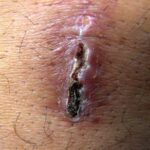My Story
I have firsthand knowledge of how quickly Methicillin Resistant Staphylococcus Aureus (MRSA) can attack your body. At the beginning of September, I cut my toe and didn’t really think much of it. Four days later I was in my local emergency room with a 103 degree fever, chills and feeling extremely drained. In a mere four days my toe started turning purple, the skin started to slide off my toe and there was an extreme amount of puss oozing from the cut.
An attending physician from the Foot & Ankle Department was called in for a second opinion and I was admitted, put on intravenous antibiotics and scheduled for surgery the next morning. It was unclear how things would go, but they did stress that there was a very good chance that my toe would have to be amputated to save my foot. It was then and only then that the severity of the situation hit home. Even so, I joked about it and figured, “better a toe than an entire foot“. When I woke up from surgery my foot was heavily bandaged so I didn’t know how bad things were; I was briefed about an hour later and told that the infection was worse than they initially thought and they couldn’t save my toe.
Fast forward two months; MRSA seems to be in the news every day. Our local high schools had a scare and their football field was closed for testing. The results were good and the games were allowed to resume but eleven players on the team had tested positive for it. It is suspect that they contracted it from gym equipment and skin surface contact. Yes, MRSA can be spread through sweat, open cuts and sores as and most commonly coming in contact with contaminated medical equipment.
For the two months that followed my amputation and release from the hospital I met with the Infectious Disease Team to be tested to see if I had any residual infection. It was at this time that I met two other people who had also contracted MRSA but were clueless as to where exactly they came into contact with it. We all had the same symptoms, diagnosis and ghastly outcome. To say that you become super paranoid abut cuts and scrapes after having MRSA is an understatement.
What can you do to protect yourself from MRSA and its various strains? Short of putting yourself in a plastic bubble, common sense is your best weapon. Avoid walking barefoot in your local gym or health club shower and changing area. Clean any cuts or scrapes as soon as possible, apply an antibiotic cream and bandage. If you are a diabetic check your feet often for blisters or sores, if you see anything suspicious contact your doctor as soon as possible. An open foot ulcer is nothing more than an open invitation for Staph or MRSA to pay you a visit.
Some have said that MRSA is the end result of the publics dependency on antibiotics. The simplest explanation is an analogy to bugs and rodents; if you continually use pesticides to try to kill them off eventually they become immune to them. In many ways, that is MRSA.
The Facts
In the health field, knowledge is protection. A wise man once said that you should never ignore your enemy but rather try to learn everything possible about him, knowledge yields power. If you work in a health care setting then chances are you are familiar with MRSA, for everyone else, this article will help shed some light on one of the most challenging problems in the medical community.
MRSA is an acronym for Methicillin Resistant Staphylococcus Aureus but can also be labeled ORSA or Oxacillin Resistant Staphylococcus Aureus. If you’ve ever heard the term “superbug” used, that is what they are referring to. The first strain of it surfaced in the United Kingdom in early 1961 but since then, other countries have reported cases of mutated strains in Norway (ST125-MRSA-IV) and Spain. The United Kingdom reports that EMRSA15 and EMRSA16 are the most popular of the strains. Oddly enough, it is genetically identical to ST36:USA200, the strain prevalent in the United States.
MRSA is a strain of bacteria that is immune to almost all types of treatment (antibiotics / penicillin). Basically it is something that can’t be killed with most of the medications that we have at our disposal. So how do you treat something that is resistant to medication? Public education is a good place to start. In early 2007 reports surfaced that 4.3% of all patients in United States hospitals tested positive for MRSA. It can be spread a number of ways but in most cases, it is transmitted in a hospital or clinical setting by contact with a contaminated person or their personal effects.
MRSA’s symptoms vary from person to person but generally consist of redness, oozing or weeping of a cut or deep gash, extreme tenderness, a spiked fever, sweats and chills, loss of appetite, nausea and discoloration of the surround skin. My symptoms were a high fever, purple and black marks around the cut, pink puss that oozed almost non-stop and an almost complete loss of appetite.
MRSA is not isolated to humans, cases have been found in canines and livestock, specifically pigs. The reverse zoonosis was first documented in the spring of 2005 at the Catholic University of Nijmegen. It remains to be seen how far MRSA will spread and how it will mutate but the signs we are seeing at present moment do not look good.


